The animal kingdom is full of a fascinating array of baby animals, each with its own unique set of characteristics that evoke a heartwarming response in humans. This instinctual reaction can be attributed to what is known as the baby schema—a set of features such as large eyes, rounded faces, and clumsiness—found in young animals that trigger a caretaking behavior and an increase in serotonin levels, typically known as the “happiness hormone,” in people. It’s these traits that make looking at cute pictures of baby animals not just enjoyable, but also a surprisingly uplifting experience.
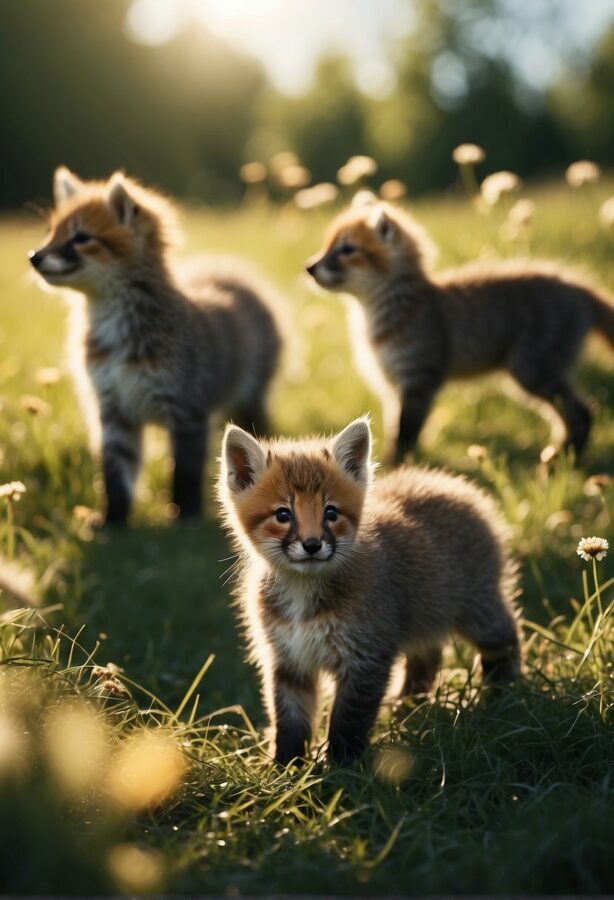
From the stilt-like legs of a newborn giraffe to the fluffy down of ducklings, baby animals symbolize new beginnings and the continuity of life through evolution. Friendly interactions with these young creatures often bring delight and a sense of kinship, bridging the gap between the wilds of nature and human society. Capturing these moments in photographs has become a cherished activity for many, offering a glimpse into the otherwise inaccessible tender moments of wildlife.
The appearance and behaviors of these juvenile creatures serve an essential purpose in their development. The heartwarming appeal of baby animals often elicits a protective and nurturing response from members of their own species—as well as from humans—ensuring these young creatures receive the care needed to navigate the early stages of their lives. Their captivating innocence is not just a source of joy but is crucial for their survival, both within their habitats and in the grand tapestry of the natural world.
Panda Cubs
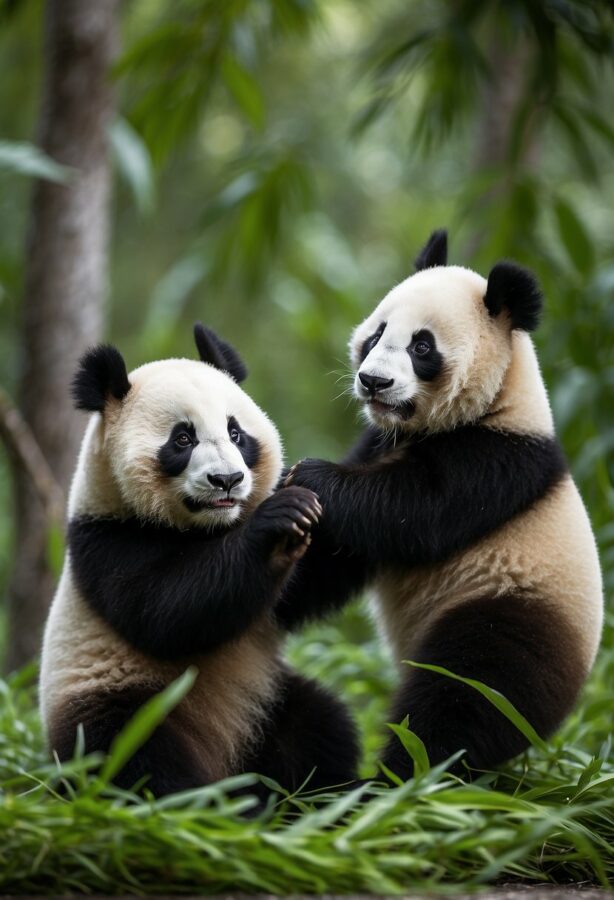
Newborn panda cubs are a heartwarming sight that can melt the hearts of animal enthusiasts worldwide. Often born in pairs, as with the cubs at Tokyo’s Ueno Zoo, these bundles of joy arrive into the world tiny, blind, and utterly dependent on their mom. At birth, a baby panda, also known as a cub or pup, typically weighs just about five ounces and has a coat of white fur.
Physical Development:
- Birth: Pink, hairless, and with closed eyes.
- Week 1: Slight fuzz of white fur appears.
- Week 6: The signature black-and-white markings start to emerge, transforming them into the fluffy, cuddly creatures loved by many.
A panda cub is totally reliant on its mom for warmth and nutrition. The vigilant mother panda constantly cradles her vulnerable pup, rarely leaving its side. The Smithsonian’s National Zoo’s giant panda Mei Xiang exemplifies motherly dedication, initially keeping her new arrival mostly hidden from view, framed only in occasional photographs and videos.
Growth Milestones:
- First Steps: Witnessing panda cubs taking their first tentative steps, such as those born to Huan Huan at Beauval Zoo, is a moment of pure delight.
- Exploration: As panda cubs grow, they become more adventurous, exploring their surroundings and displaying endearing clumsiness.
Panda cubs are among the most precious baby animals, with each stage of their growth journey offering a new level of cuteness — from the initial helplessness to their playful antics as they develop. These cute baby animals captivate the world not just with their adorableness but also through their role in wildlife conservation efforts globally.
Giraffe Calves
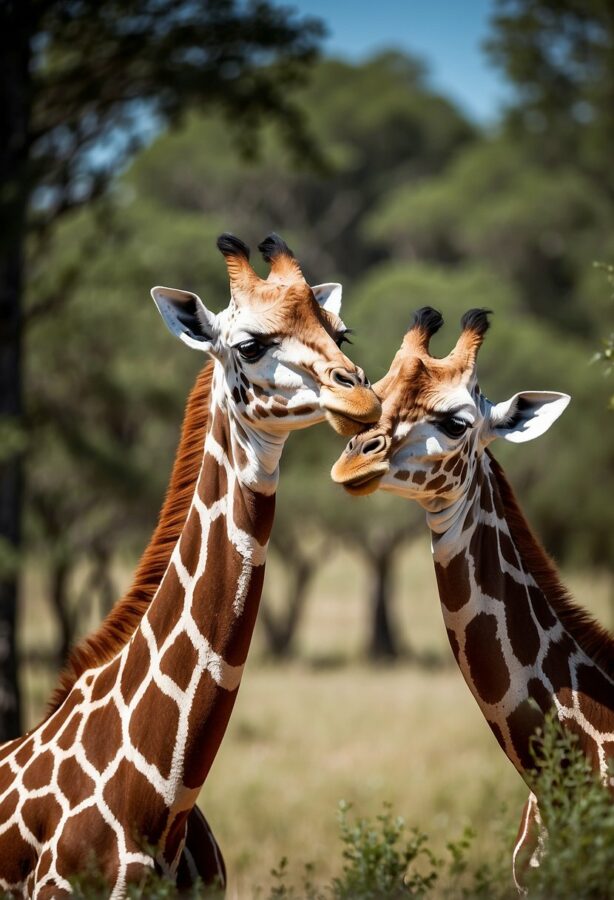
When a giraffe calf enters the world, it does so with a grand entrance, making a six-foot drop as its mother gives birth standing up. These long-legged babies are typically born around six feet tall and weigh between 100 and 150 pounds. It’s a heartwarming sight to see a newborn calf, with its large, batting eyes and tentative steps, standing up within a few hours of birth, ready to explore its surroundings.
Quick Facts:
- Weight at Birth: ~150 lbs
- Height at Birth: ~6 feet
- First Steps: Within hours
Giraffe mothers are notably attentive and protective, nurturing their young with a fierce dedication. The bond they share with their calves is visible, as they remain close, ensuring their offspring are safeguarded from natural predators like lions and hyenas. This protection is vital during the calves’ most vulnerable early months.
In the animal kingdom, giraffes have one of the longest gestation periods, spanning approximately 15 months. As a calf grows, it will nurse from its mother for about 9-12 months, yet within the first few weeks, it starts sampling vegetation.
Life Stages:
- Nursing Period: 9-12 months
- Independence: Around 2 years
- Weaning: Starts at a few weeks old
During the first weeks of life, calves learn to navigate their towering world, hiding in plain sight by lying low and blending with the terrain. This natural behavior, often mistaken as a nest, is a survival tactic. As they age, young giraffes will join groups of other juveniles in a playful and nurturing environment known as a “creche.”
Filled with curiosity and framed by spectacularly long eyelashes, baby giraffes are a delight to observe—a true marvel of nature’s design, bringing a sense of wonder and joy to all who witness their early steps in life.
Elephant Babies
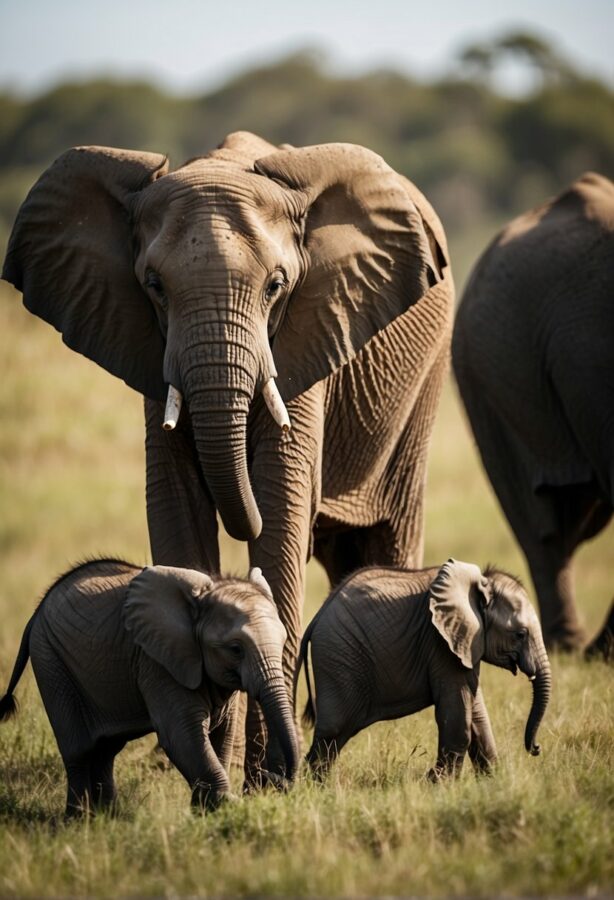
Elephant gestation is a marathon of motherhood; the pregnant period lasts from 18 to 22 months, making it one of the longest in the animal kingdom. When baby elephants, or calves, enter the world, they are a sight to behold. These robust newborns typically weigh about 250 pounds and stand approximately 3 feet tall.
Curiosity surrounds their arrival as nearly all elephant calves are born under the cloak of night. Their endearing appearance is heightened by a crown of curly black or red hair adorning their foreheads, and these gentle giants hold a profound fascination for many.
The growth of a calf is nurtured through the intake of their mother’s milk, consuming around 3 gallons daily. Although baby elephant pictures might highlight their clumsy antics, these babies are anything but inept. They exhibit strong social bonds and are often seen in the protective company of the herd, learning nuanced communication and survival skills from their elders.
In a display of nature’s brilliance, elephant calves can stand and walk shortly after birth, an essential characteristic that aligns with the herd’s migratory lifestyle.
Milestones | Description |
|---|---|
Birth Weight | ~250 pounds |
Initial Height | ~3 feet |
Night-born | 99% of calves |
Diet | 3 gallons of milk/day |
A baby elephant’s initial steps into life offer a heartwarming glimpse into the animal kingdom’s wonders and serve as a reminder of the incredible journey these majestic creatures face from the very beginning. Baby elephants represent the epitome of nature’s remarkable designs, and their early days are celebrated with a gallery of cute baby animal pictures by enthusiasts worldwide.
Lion Cubs
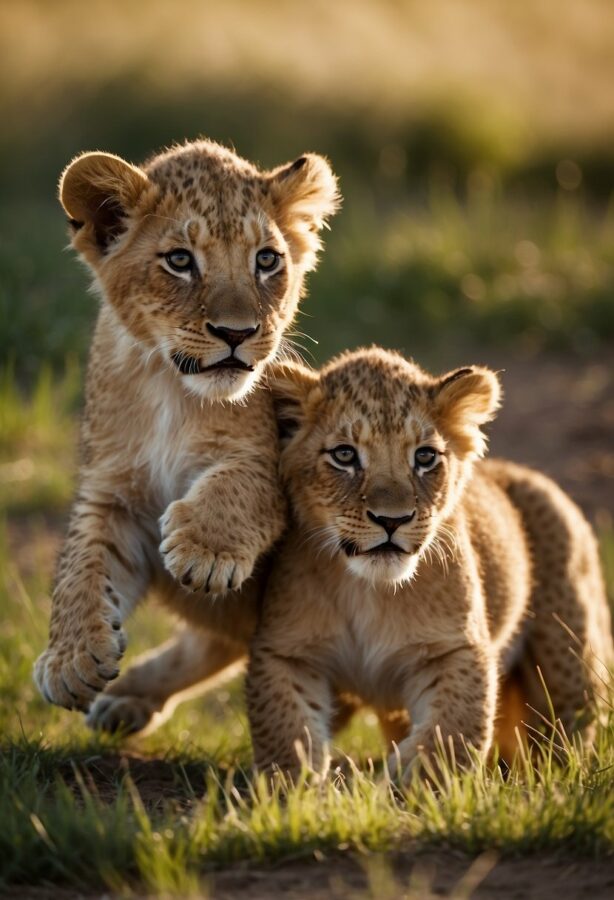
The beginning of a lion’s journey starts with its endearing early stage as a cub. These baby lions are a heartwarming sight with their playful nature and fluffy fur. A pride’s littlest members, they are born into a world teeming with the adventure of the savanna.
Physical Appearance
- Initially born without teeth, lion cubs quickly develop a set of ‘milk teeth’
- Covered in soft, spotted fur to camouflage them in the wild
Growth
- Mammals grow up quick: from 120 kg to 249 kg (264 to 550 lbs)
- Length ranges eventually between 1.4m to 2.5m (4.7ft to 8.2ft)
Pride Dynamics
- Live in close-knit family units known as prides
- Are often seen frolicking with their siblings
- Learn crucial survival skills through play
Development
Lion cubs spend their initial months hidden away before being introduced to the pride. During this time, they begin to explore and play, practices essential for their development into the magnificent and powerful adults they will become.
Age | Developmental Milestone |
|---|---|
Birth | Helpless, reliant on mother |
A few weeks | Start to grow baby teeth |
6 months | Begin exploring more widely, meet pride members |
These cubs, when they grow older, will play a significant role in their ecosystem. They are not only captivating in their innocence but are also future kings and queens of their domain, crucial in maintaining the balance of the savanna. The sight of lion cubs playfully interacting is a tender and enchanting glimpse into the early life of one of nature’s most respected mammals.
Dolphin Calves
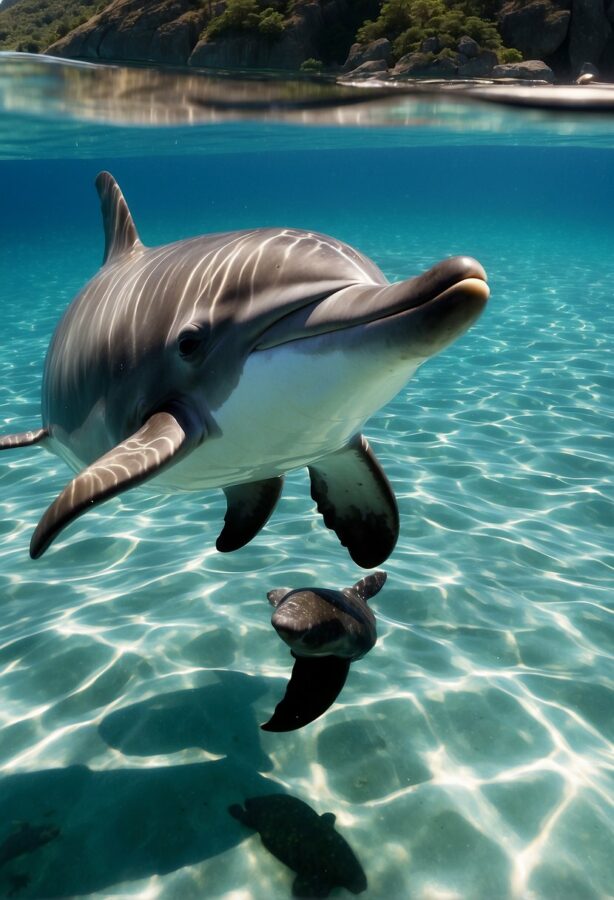
Dolphin calves, the adorable young of one of the ocean’s most graceful creatures, bring a sense of wonder to those who observe them. These aquatic infants are born after a gestation period of 12 months and immediately capture hearts with their playful nature.
Quick Facts:
- Name: Called calves
- Breath: Use blowholes on top of their heads to breathe
- Capacity: Can fill 80-90% of their lungs with each breath, compared to humans at 10%
- Family bonds: Calves stay with their mothers for 2-6 years
Swimming alongside their mothers, dolphin calves are quick learners. They must surface to breathe from their blowholes and develop their swimming skills. These miniature cetaceans are also fed a rich milk from their mothers, which helps them grow strong and swift in the aquatic environment.
Dolphins are social animals, and this begins in infancy. The calves swim in pods, learning to communicate and socially interact with the help of their family members. Valorizing the bonds within these groups, researchers have found that dolphin mothers use what can be likened to “baby talk,” simplifying their complex whistles and clicks when communicating with their young. This endearing method aids in the development of the calves’ communication skills.
Fish and other sea creatures often become playmates or objects of curiosity for the energetic dolphin calves. These infant mammals exhibit behaviors that can only be described as frolicsome and endearing, showing the lighthearted side of aquatic animals and adding to the charm of the ocean’s wonders.
See Related: A Guide to Animals in Antarctica: Wildlife on a Frozen Continent
Baby Kangaroos
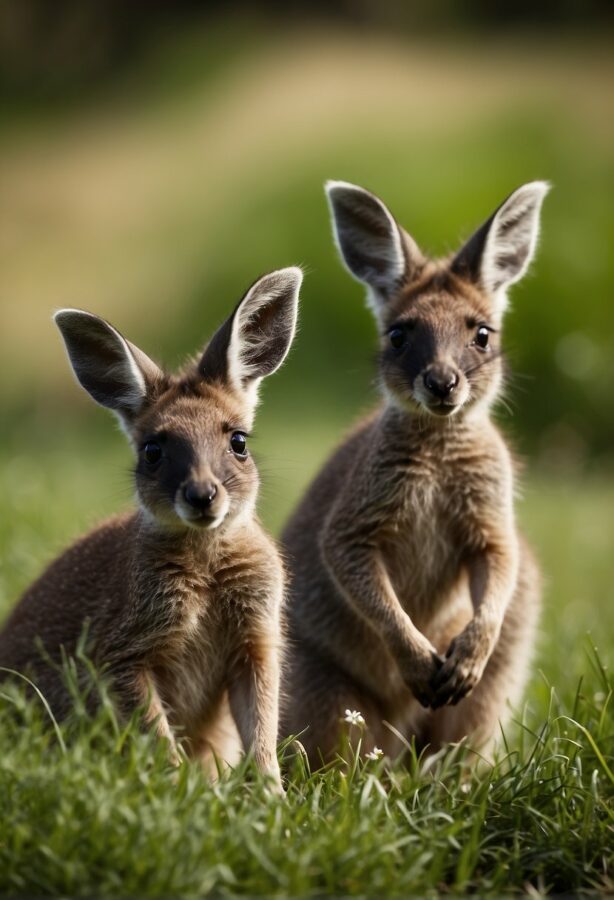
Baby kangaroos, renowned as joeys, captivate with their inherent charm. These marsupial infants begin their journey in Australia, emblematic of the rich tapestry of wildlife native to the continent. A Joey’s first home is its mother’s pouch, a nurturing space providing warmth and security.
Life Begins: After a gestation of just around 30 days, a joey is born tiny and underdeveloped. From birth, it embarks on an incredible journey to the pouch where it continues to grow and develop.
Feature | Description |
|---|---|
Size | Joey is about the size of a lima bean at birth |
Development | It latches onto its mother’s nipple in the pouch for nourishment |
Pouch Time | The joey continues its development in the pouch for about 6-9 months |
Upon reaching the outside world, the pouch remains a haven for joeys to seek refuge and receive nutrient-rich milk as they grow. The transformation from a vulnerable infant into a sturdy, energetic kangaroo is heartwarming. It’s only at about eight to ten months that joeys start to venture more confidently, taking in the sights and sounds of their environment though they may continue to nurse until they are around 12 months old.
Whether hopping alongside their mother or peeking curiously from the pouch, baby kangaroos enchant with their spirited antics. They’re a heartening symbol of life’s resilience and the tender care that defines the marsupial way.
Penguin Chicks
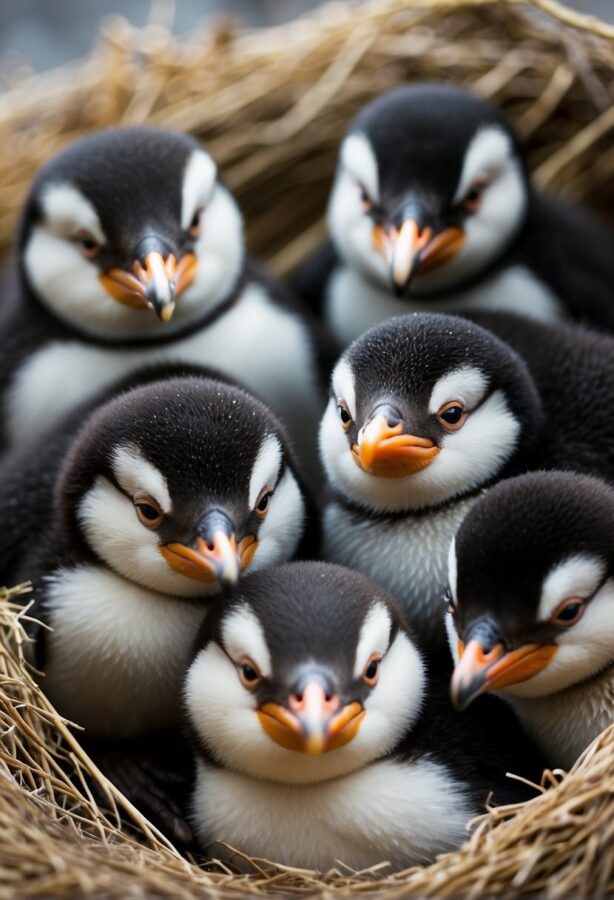
Penguin chicks, often referred to as ‘nestlings’ or simply ‘chicks’, are the young of the penguin species. These fluffy hatchlings are born with a softer, downy plumage that keeps them warm in their cold environment. Chicks rely heavily on their parents for warmth and protection against the harsh weather and potential predators.
Physical Characteristics
- Down Feathers: Soft and insulating
- Color: Grey or brown, later maturing to adult colors
- Beak and Flippers: Proportionally smaller than adults
Behavior and Development
- Family Structure: Chicks gather in groups called crèches to maintain warmth and safety while their parents are away fishing.
- Growth Journey
- Swimming: Initially clumsy, they adeptly adapt to their aquatic life over time.
- Feathers: They shed their downy feathers for waterproof ones before venturing into the sea.
Fun Facts
- While adult penguins are known for their swimming capabilities, chicks must grow into their flippers.
- They vocalize to communicate, often creating a symphony of peeps that resonate across the flock.
Lifecycle Stage | Detail |
|---|---|
Hatchling | Emerges from the egg |
Crèche Age | Joins a group ~16-45 days |
Fledgling | Ready to swim and fish |
As they grow, the undeniable cuteness of penguin chicks captures the hearts of anyone lucky enough to witness them waddling and tripping, learning to navigate the world. Watching them play, huddle, and interact brings a heartwarming reminder of the enduring spirit of life in even the coldest corners of our planet.
See Related: Exploring the Biodiversity: The Fascinating Animals of El Salvador
Polar Bear Cubs
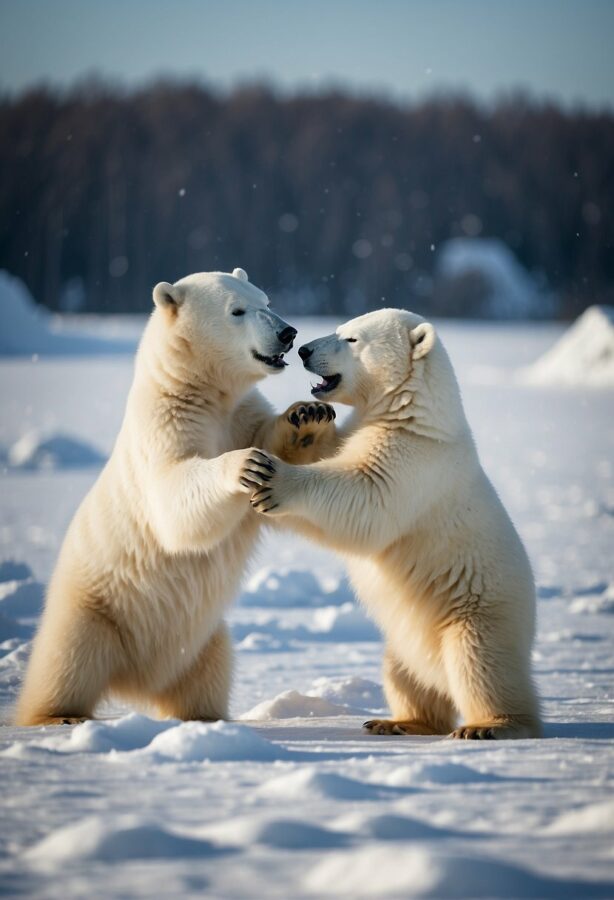
Polar bear cubs are born into the icy, unforgiving environment of the Arctic, where they rely on the nurturing care of their mothers in their den. These tiny newborns start their lives weighing a mere 1 pound, almost invisible against the vast white ice. Their fur is so fine at birth that they may appear hairless, their eyes closed, and their bodies extremely small—measuring only about 12 inches in length.
Adaptation in Infancy
- Size at birth: 1 pound (approximately 500 grams)
- Birth length: 12 inches (30 cm)
- Compared to adult size: A stark contrast to the parents, who weigh up to 1,500 pounds
- First steps: Taken after about four months in the den
- Weight gain: They may weigh between 22 and 33 pounds by the time they leave the den in spring
Mother polar bears dedicate themselves to feeding and protecting their cubs, providing rich milk and warmth. During the first months, the cubs grow quickly, nurtured by their mother’s milk which is high in fat.
As they emerge from their dens for the first time, the brightness of the world can be overwhelming. Yet, these heartwarming balls of fluff are surprisingly resilient and soon start to explore their frozen habitat. They playfully tumble on the snow, learning essential survival skills, and before long, their once fine coat starts to thicken and become as white as the surrounding arctic ice.
These baby polar bears represent new life in a harsh climate and embody the enduring spirit of one of nature’s most iconic creatures in the Arctic wonderland.
Fox Kits
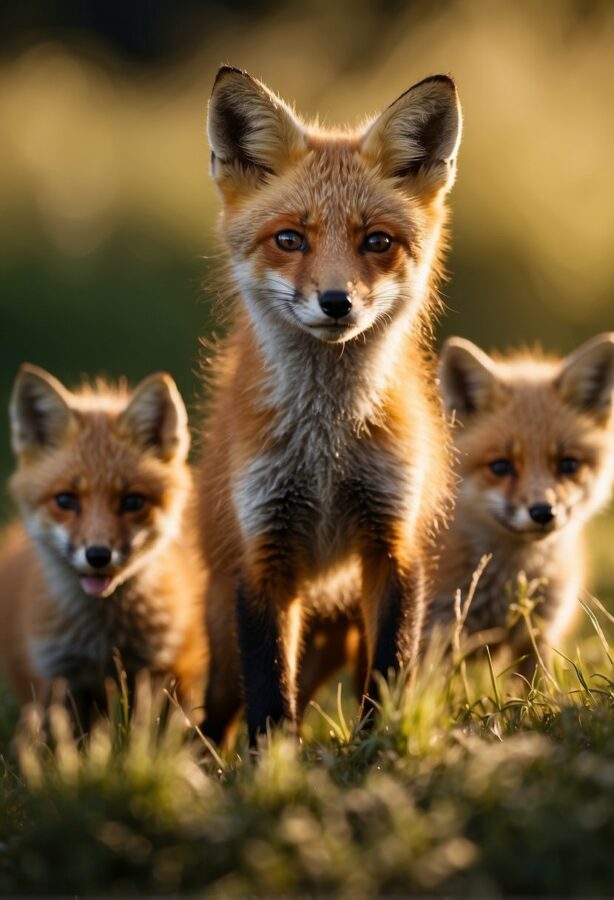
A fox kit represents the charming beginning of a fox’s life cycle. These baby foxes are endearing examples of wild animals, with fluffy fur, big ears, and engaging personalities. Born in smaller groups known as litters, usually comprising 1 to 10 kits, these little ones spend the early stages of their lives in the safety of a den.
Characteristics of Kits
- Appearance: Small, with soft fur and distinctive large ears.
- Weight: Weighing just ounces at birth.
- Growth: They grow rapidly, maturing into adults in less than a year.
Fox kits develop quickly, both physically and behaviorally. Within weeks, curiosity overcomes them, and they begin to explore outside their den under the watchful eyes of their parents. Despite their rapid growth, kits exhibit playful behavior reminiscent of domestic puppies, which makes them particularly heartwarming to observe.
Habitat and Care
- Den: A secure base created by parents.
- Family Structure: They are born into a supportive family environment.
- Parental Care: Mother and father foxes take part in nurturing their young.
Baby Owls

Baby owls, or “owlets,” are the heartwarming young of one of the most intriguing nocturnal birds. These small fluff balls emerge from their eggs entirely dependent on their parents, with their eyes closed and a strong instinct to hoot for attention.
Growth and Development
When born, owlets like those of the Great Horned Owl weigh a mere 35 grams (1.2 ounces). It’s fascinating how quickly they grow, with some species doubling their weight in just a couple of weeks. As they mature, their downy feathers begin to develop the sleek, silent flight characteristic of adult owls.
Physical Characteristics
Despite their eventual prowess as flying predators of the night, baby owls are initially helpless. Their endearing clumsy movements and disproportionally large eyes add to their cuteness factor. Some owlets of particularly small species, such as the Elf Owl, start life weighing as little as a bumblebee.
Behavior
From the safety of their nests, owlets are known to practice their hooting—the signature call of owls—well before they’re ready to take to the skies. This call reinforces the familial bond and is essential for communication within their species.
Species | Birth Weight | Unique Trait |
|---|---|---|
Great Horned Owl | ~35g | Rapid weight gain |
Elf Owl | ~40g | Smallest of owls |
As nighttime hunters, owlets are trained in the art of being nocturnal. They begin by observing their parents and gradually participate in hunting as they learn the ropes of flying and navigating the dark.
Tiger Cubs
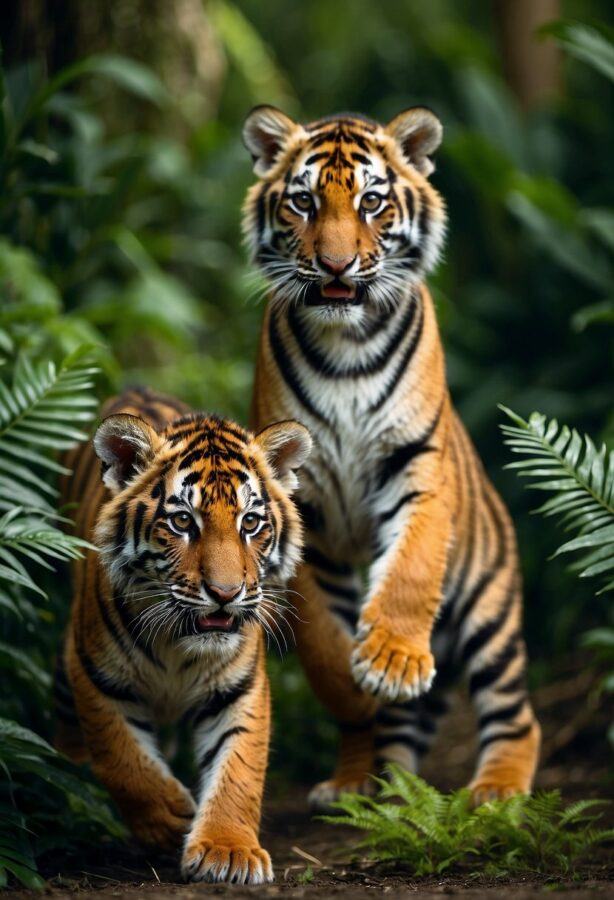
Tiger cubs are the epitome of wild cuteness, emerging into the world with striking stripes unique to each individual. These little felines are born after a gestation period of about three and a half months, and litters can be as diverse as one to seven cubs. However, typically only two survive into adulthood due to various natural challenges.
At birth, these baby tigers are blind and utterly dependent on their mother for protection and nourishment. Within a week or two, their eyes open, revealing the world they’ll soon learn to navigate. Within a month, they start to wrestle and play with their siblings, which isn’t just adorable but essential for their development.
Feature | Detail |
|---|---|
Weight | Approximately 1 kg at birth |
Eyes Open | 6-12 days after birth |
Weaning | Around 3-6 months old |
The cub that displays the most assertiveness is often considered the dominant one, and while it’s not always the largest, this cub tends to be favored by their mother. These aspirant hunters learn the ropes by observing their mother’s techniques, honing skills that will, in time, make them masters of the jungle.
By around six months of age, tiger cubs begin accompanying their mother to watch her in action. This is a critical time for learning how to hunt and survive in the wilderness. It takes about two years for these charming youngsters to become independent, and as they mature, their playful antics give way to the majestic grace of an apex predator.
Monkey Babies
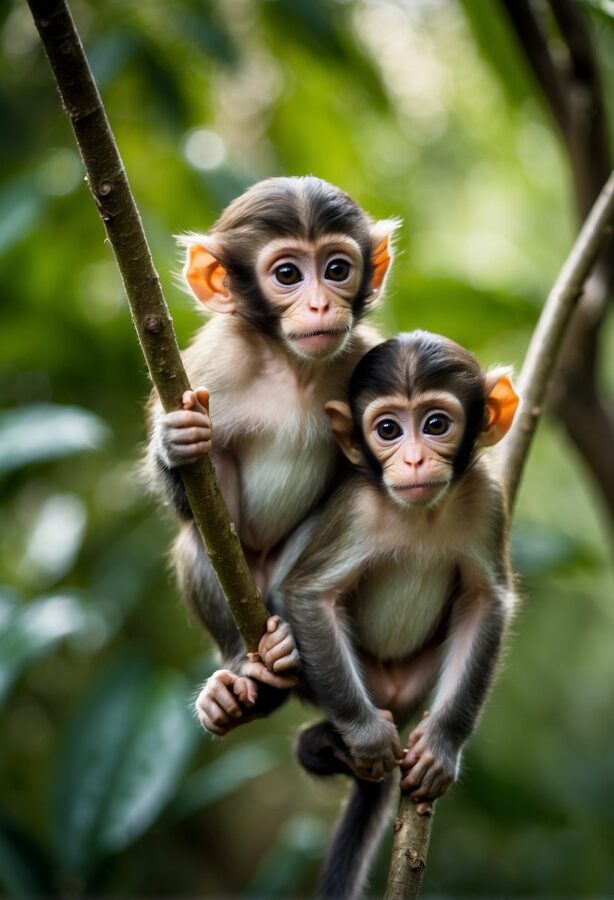
Monkey babies, often referred to as infants, bring a touch of heartwarming joy to the jungle with their playful antics and undeniable cuteness. As members of the primate family, they share numerous traits with human infants, including a strong bond with their mothers and a lengthy childhood.
Habitat and Lifestyle:
- Jungle: Their natural habitat.
- Trees: The playground and home for baby monkeys.
Behavior:
- They are highly social creatures, beginning their life clinging to their mother’s fur.
- Baby monkeys are quick learners; climbing, a vital skill for their survival, is picked up by observing and mimicking their elders.
Diet:
- While bananas are a popular food, their diet is diverse, including leaves, fruit, and insects.
Fun Facts:
- A baby monkey’s bright, curious eyes and endearing expressions captivate observers.
- Their playful nature often involves swinging from branch to branch, showcasing their agility.
As they grow, these little primates continue to explore and become more independent, yet their irreplaceable charm remains a constant highlight in the richness of the jungle.
Zebra Foals
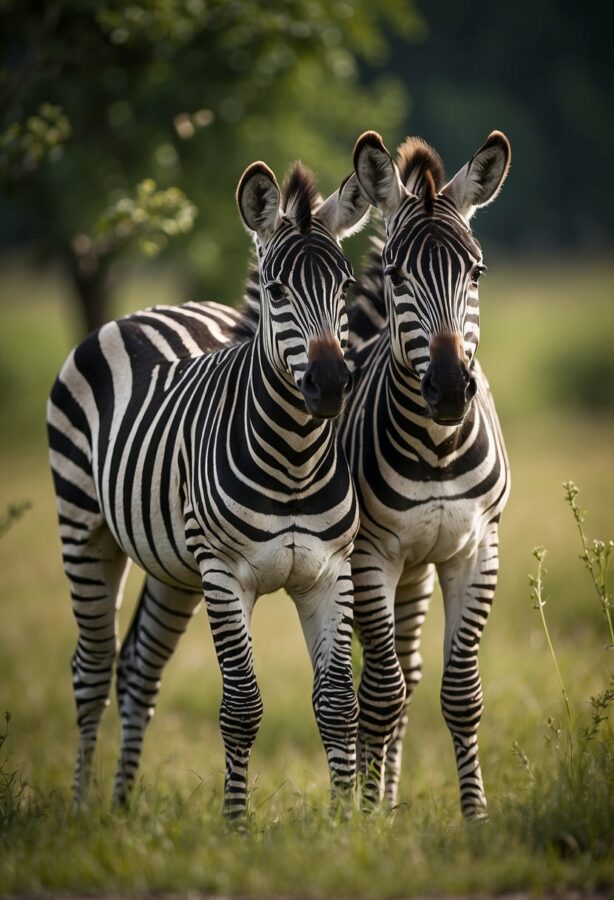
Zebra babies, known as foals, are heart-warmingly spotted with the iconic black and white stripes of their species, though sometimes they start with a softer brownish hue. Within moments after birth, foals exhibit a captivating precociousness; they stand on their spindly legs within 10 to 20 minutes and commence running not long after—showing an adorable zest for life.
On the vast savanna, the stripes of a zebra foal do more than just appeal to the eye; they serve an important role in camouflage and insect deterrence. Each zebra’s stripes are as unique as fingerprints, adding to their individual charm.
At birth, the bond between mare and foal is vital. Initially, mothers keep their newborns separate from the herd to strengthen this connection and to ensure the foal memorizes her unique stripe pattern, scent, and call—critical for survival among the sea of stripes in the herd.
While their beginning in life may seem challenging, with predators lurking within the savanna, zebra foals benefit from the protection offered by the herd. Their innate cuteness factor is undeniable, especially when observed in groups, playfully nudging one another and exploring their environment.
Interestingly, fillies and colts are the names given to female and male zebra foals respectively, and these endearing terms remain in use until they reach the age of three. In their early years, they learn the ways of the savanna, growing quickly not just in size but in social understanding within their herd.
Conservation and Hope for the Future
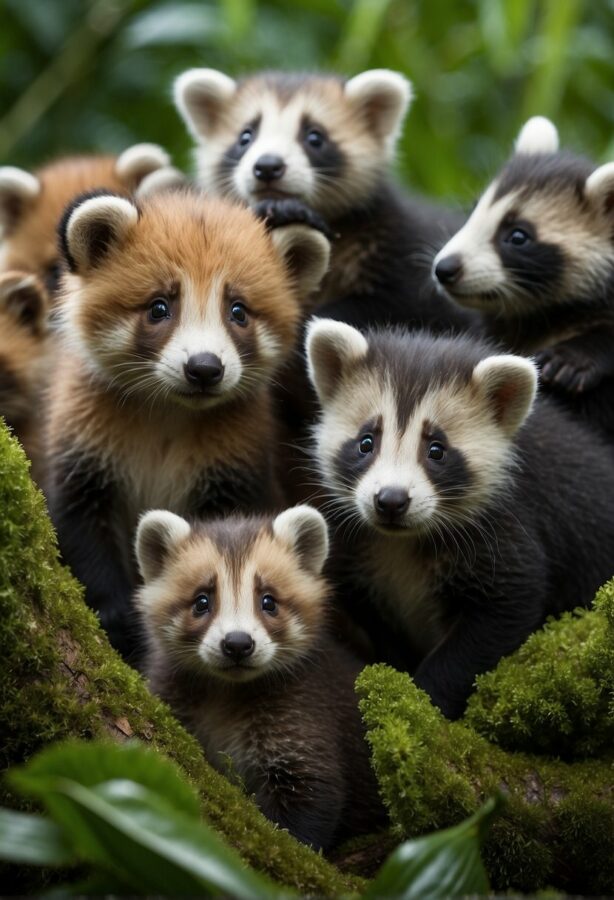
In the face of climate change and habitat destruction, conservation efforts provide a glimmer of hope. They underscore the importance of habitat preservation and bolster populations of endangered species. Nature’s tenacity is evident in the resilience of its young, and nowhere is this more heartwarming than in the births of baby animals within conservation programs.
At Chester Zoo, a baby tree kangaroo represents hope for its species. These adorable marsupials, threatened by habitat loss, are part of educational programs that inspire sustainable living and wildlife protection.
Similarly, aquatic salamanders known as olms, or ‘baby dragons,’ enchant with their delicate features and elusive nature. Their continued survival is a testament to the success of habitat conservation efforts, offering assurance that even the rarest creatures have a fighting chance.
Successful Conservation Projects | Species |
|---|---|
Chester Zoo’s baby boom | Various endangered species |
Aquatic salamander protection | Olms (Baby Dragons) |
Another critical tool for conservation is the role of artificial insemination in zoos and aquariums. It expands genetic diversity, strengthening animal populations.
Educational programs disseminate knowledge about these topics, empowering the public to engage in protecting wildlife. Such initiatives bring us closer to a future where human actions are aligned with the sustainability of all creatures, big and small.
Related Resources: